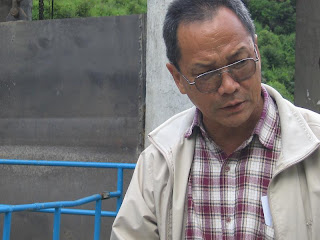750 Mw West Seti and far western region
 By SB Pun
By SB PunThe Far Western Stakeholders' Forum organized an interaction in August 2007 on 750 Mw West Seti hydroelectric storage project and its developmental impact on that region. Two papers on technical and environmental aspects were presented that also touched some commercial issues. Interestingly, a high number of ministers and parliamentarians from that region were present.
However, due to their “prior engagements”, most of them asked to have their “say” earlier. The majority of them extolled the virtues of West Seti to developing the backward far western region. Apparently, they have forgotten Pashupati Shumsher Rana's famous “the sun rising from the west” phenomenon during the ratification of Mahakali Treaty.
Warning that no negative criticisms, Article 156 of Interim Constitution on natural resources or the 90 cumecs augmented flow, would be welcomed, most of them exited from the forum after their say. This prompted the participants from the floor to quip “we are not here to hear their say, we are here so that they may hear what we say”. A genuinely infuriated participant, whose house and lands were to be submerged by West Seti project, showed a letter from the Ministry of Population and Environment that asked him to pay Rs 50,000 for the environmental impact assessment report that he had asked for.
The export-designated 750 Mw West Seti saga started in 1994 when the Australian Snow Mountain Electric Corporation (SMEC) signed a memorandum of understanding with Nepal agreeing to provide 10 percent energy free on top of the prevailing 2 percent royalties.
Informally, SMEC revealed that they were aiming for US Cents 7.50 per unit from India. This peaking power price appeared reasonable as the just concluded 60 Mw run-of-river Khimti power purchase agreement (PPA) had US Cents 5.20 per unit. Thirteen years later in 2007, India “wore” down SMEC to a PPA for US Cents 4.95 per unit for peaking power. As royalty is tied to PPA price, low power price unfortunately means low royalty for Nepal. Besides, Nepal has chipped in US $ 45 million (ADB loan at the medium high LIBOR interest rate) as 15 percent equity stake “to ensure the project moves forward” and the government trumpets that SMEC bowed to its pressure to provide free energy and not cash as agreed earlier.
Apparently, Nepal has done no homework at all in the last thirteen years. The price of oil in 1994 was about US$ 7 per barrel, now it hovers around US$ 70. With the huge energy thirst of China and India, energy experts predict that by 2009 the price of a barrel of oil would shoot to US$ 100.
The run-of-river Khimti's price has now shot up to US Cents 8.40 per unit. No mention is made where SMEC would provide the 10 percent free energy. Is this at the power house site, Kohalpur or Butwal? Providing cash to Nepal was a clever way to wriggle out of constructing costly transmission line in difficult hilly terrain.
Besides, the government made no attempt to review the accruing royalties. The 2058 hydropower policy states that all export oriented storage projects would pay an annual capacity charge of Rs 500 per Kw and an energy royalty of 10 percent for the first 15 years then Rs 2,000 per Kw and 15 percent energy royalty afterwards.
For no reason, the government is content in 2064 with the 2049 policy of Rs 100 per Kw and 2 percent as royalty up to 15 years then Rs 1,000 per Kw and 10 percent as royalty after that.
Based on SMEC's projection that West Seti would generate 3,600 million units annually and based on the 2049 and 2058 policies a tentative per annum revenue and loss to Nepal is given below:
Thus by toeing the old 2049 policy and not the new 2058 policy, Nepal is set to lose over Rs 122 crores per annum. As 50 percnt of the accrued royalty is retained in the region, the Far Western region has much to lose. One can argue that implementation of 2058 policy may jeopardize the project's financial viability. But peaking power at US Cents 4.95 per unit is undoubtedly dirt cheap, besides availing augmented water through default.
Informally, an official justified that the government was merely following the Electricity Act 2049 and that hydropower policy 2058 is yet to be enacted. But when the government goes ahead and amends SMEC's Project Agreement for the eighth time, why was not this better 2058 policy insisted on? Or for that matter, when the government chipped in US$ 45 million why wasn't the application of 2058 policy made a pre-condition? This is something that all Nepalis in particular the Far Western Stakeholders, should ask the government. Better royalty meant Nepalis, whose houses and lands get submerged for perpetuity, will have a better chance of getting “at par or better” living standards wherever they are shifted to!
Royalty 2049 Policy 2058 Policy Loss to Nepal/year
Capacity charge/annum Rs. 7.5 crores Rs. 37.5 crores Rs 30 crores
Energy charge
Upto 15 years 2% 10% 8%
In million units 72 360 288
@ 4.95 US cents per unit US$3.6 million US$17.8 million US$14.2 million
@ NRs 65 per $ Rs 23.4 crores Rs 115.7 crores Rs 92.3 crores
Total Rs 30.9 crores Rs 153.2 crores Rs 122.3 crores
Source : The Kathmandu Post, Posted on: 2007-08-14 21:07:35 (Server Time)
Picture: Writer SB Pun, Former Managing Director of Nepal Electricity Authority
Labels: hydropower

3 Comments:
Good post.
By Anonymous, at 10:18 PM
Anonymous, at 10:18 PM
Keep posting stuff like this i really like it
By Anonymous, at 12:57 PM
Anonymous, at 12:57 PM
I would like to exchange links with your site www.blogger.com
Is this possible?
By Anonymous, at 4:37 PM
Anonymous, at 4:37 PM
Post a Comment
<< Home